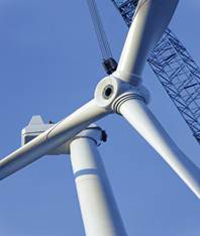Energy and utility projects
The DNR's Environmental Analysis and Sustainability Program (EAS) is responsible for coordinating the review of proposed energy and utility projects.
Project management within DNR is provided by EAS staff who act as the main point of contact for project applicants, the Public Service Commission (PSC), other DNR programs and affected stakeholders. We provide statewide guidance and consistent application of the regulatory processes established by statutes and rules.
Environmental permitting for utility projects that impact waterbodies, wetlands or endangered resources is also the responsibility of EAS staff. See Utility permitting for more information.
The department's involvement in various kinds of projects is described below.
Electric power generating plants
The DNR is not responsible for siting approval of coal, oil or natural gas-fired power plants. Siting authority for these kinds of facilities rests with the PSC.
The DNR administers permit programs that control how much pollution power plants can release to the air, water and land as well as how much water can be withdrawn from surface and groundwater sources. The DNR also regulates structures, fills and dredging projects in navigable waters and wetlands and oversees shoreland and wetland zoning programs.
Reviews for threatened and endangered resources are also the department's responsibility. Any combination of these permits and reviews may be required for a power plant. See Power plants for more information about the major permitting programs within the DNR pertaining to power plant siting and licensing.
Natural gas, petroleum and water transmission pipelines
Siting and construction of natural gas pipelines within Wisconsin are overseen by the PSC according to the PSC filing guidelines. The siting and construction of interstate pipelines are regulated by the Federal Energy Regulatory Commission (FERC). The siting and construction of pipelines that cross international boundaries are overseen by the U.S. State Department.
The DNR's EAS staff review construction projects for petroleum, natural gas and water transmission pipelines, and are responsible for environmental permitting for pipeline projects.
Other kinds of pipeline projects are overseen by other DNR programs. For information on DNR oversight of local water main projects, see Drinking water. See Wastewater for information on DNR oversight of storm sewer and sanitary sewer projects.
Electric transmission and distribution lines
The PSC is responsible for siting approval of electric lines. For PSC requirements, see Requirements for Power Line and Power Plant Development.
The DNR's EAS program is responsible for advising PSC, and for environmental permitting for electric line projects.
Telecommunication facilities
The construction of telecommunication facilities often involves crossing or impacting wetlands and waterways. Telecommunication facility construction and operation may also affect threatened and endangered species. The DNR's EAS program is responsible for environmental permitting for telecommunication projects.
Wind power facilities
The DNR fully supports the siting, development and use of clean and renewable energy facilities based on sound scientific information and in a manner that is sustainable for wildlife and other natural resources.
Wind projects pose different siting issues than combustion-based electric generation facilities. Wind projects require larger areas of land per megawatt of generation. The interaction of birds and bats with wind turbine blades and related facilities is a well-documented impact concern.
The DNR does not have authority over the siting of wind projects. The PSC must approve wind projects that are 100 megawatts or larger, or those built by a state-regulated utility. Other wind projects must be approved by the local government but must adhere to PSC wind siting criteria. The DNR works with the PSC on wind projects through a cooperative agreement.
The department has regulatory authority for any wetland and waterway crossings by temporary and permanent access roads, connector lines and turbine construction. The DNR also has authority over construction site erosion control and the protection of state-listed threatened and endangered species. See Wind power for more information about the DNR review of wind power facilities.
Hydroelectric generation
The Federal Energy Regulatory Commission (FERC) has jurisdiction over most large dams in Wisconsin that produce hydroelectricity. There are approximately 150 of these dams in the state. The DNR regulates the remaining dams.
While the department regulates many dams, it is the owner that makes the decision on whether to explore electric generation options at their dam. If the owner decides to pursue hydropower, the DNR works with them to review the project and explore permitting issues. The FERC is also involved in the permitting process. Permitting is required for new hydro dams and installation of systems in existing dams, even for very small systems. See Hydroelectric for more information about DNR and FERC regulation of hydropower facilities.
Additional resources
- Utility permitting
- Wisconsin Public Service Commission (PSC)]
- Federal Energy Regulatory Commission (FERC)
- Focus on Energy
Contact information
For information on energy and utility projects, contact:
| Kyle McLaughlin Section chief Integration Services Section |
Macaulay Haller Wetland & waterway permits 608-347-0240 |
| Geri Radermacher Wetland & waterway permits 262-239-0994 |
Samantha Whitens Erosion control & storm water management 608-301-6110 |
| Stacy Rowe Endangered & threatened resources review 608-228-9796 |

